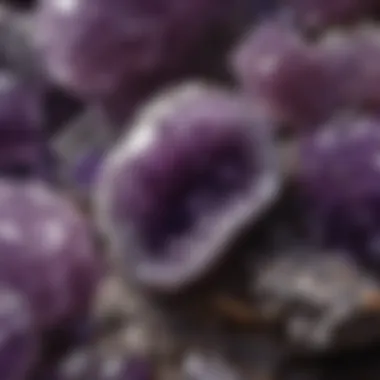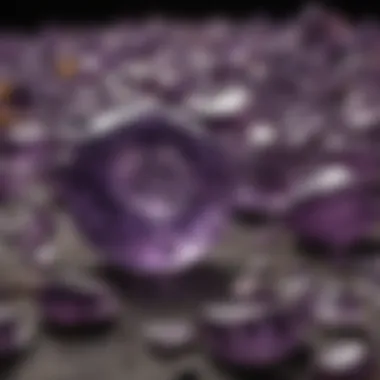The Intrinsic Worth of Amethyst Rocks Explained


Intro
Amethyst is a popular crystal among collectors. Its beauty and significance draw many enthusiastic mineral and rock enthusiasts. Understanding this stone requires knowledge of its physical properties, demand within the market, and cultural importance. Each aspect influences the value of amethyst rocks.
Many collectors regard the quality of amethyst as pivotal. Additionally, ethical considerations surrounding its sourcing add complexity to the assessment process. This exploration offers insightful perspectives on how various factors interact to establish the intrinsic worth of amethyst rocks.
Rock and Fossil Identification
Types of Amethyst
Different types of amethyst exist, and recognizing them helps collectors effectively assess value. Here are notable forms:
- Brazilian Amethyst: Known for its rich color and clarity.
- Uruguayan Amethyst: Ideal for vibrant, dark hues.
- African Amethyst: Typically lighter but with beautiful shades.
- Chevron Amethyst: Contains white bands, important these enhance collector desirability.
Characteristics to Look For
When examining amethyst rocks, certain characteristics indicate quality:
- Color Tone: Vivid and deep purple color indicates high quality.
- Clarity: Lack of inclusions enhances value.
- Cut: Precision in cutting affects appearance.
- Size: Larger specimens may fetch higher prices but rarity of high-quality gems factors as well.
Tools for Identification
Several tools aid in identifying and assessing these gems:\n1. Loupe: A 10x magnifying lens reveals clarity.
2. Scale: Measures weight accurately.
3. Pointer: Helps evaluate hue and saturation closely.
These tools offer essential assistance in evaluating amethyst effectively.
Collecting Tips and Techniques
Best Practices for Collecting
When constructing a collection, keep in mind:
- Develop a keen eye for quality.
- Stay informed about the grading systems.
- Attend gem shows to network with suppliers.
Locating Prime Collecting Sites
Some regions stand out as optimal collecting spots for amethyst. Key locations include Brazil, Uruguay, and Zambia, which are renowned outputs of quality stones. Further research on local geology offers insight about rock exposure as well.
How to Safely Extract Specimens
Safety is key during collection:
- Wear gloves and goggles for protection.
- Follow ethical guidelines and respect nature.
- Use hand tools thoughtfully to minimize damage.
Preservation and Display
Techniques for Preserving Rocks
To maintain the integrity of amethyst:
- Limit exposure to heat and sunlight.
- Regularly clean with mild soap and water.
Proper Storage Methods
Concepts for storing these crsytal types include:
- Use padded boxes to mitigate impacts.
- Maintain moderate humidity levels.
Creative Display Ideas
Visually appealing displays attract attention. Displays may incorporate:


- Elegant glass cabinets.
- Customized stands for showcasing larger pieces.
Geological Insights
Geological Formation
Amethyst primarily forms in volcanic rocks such as basalt and rhyolite. Understanding the geological environment provides crucial context for appreciating the stone.
Historical Significance
Historically, amethyst has been valued for its beauty, religious significance, and associations with royalty. Many cultures have revered this crystal over time, enhancing its cultural richness.
Notable Discoveries
Recent discoveries are noteworthy improvements. Curated specimens from South America and various catalogs compile incredible amethyst findings, driving both academic and collector interest further.
Understanding the geological roots and historical context of amethyst enhances appreciation for its beauty and value.
The insights discussed inform future decisions that fine-tune collections of amethyst rocks.
Understanding Amethyst
Amethyst, a vibrant purple variety of quartz, holds a distinguished place in both geological study and collecting circles. Understanding its properties, formation, and applications can greatly enhance one's appreciation for this remarkable mineral. It is not only sought after for its aesthetic appeal but also treasured for its historical and economic significance. This section will delve into the physical characteristics of amethyst, as well as its geological formation and sources, providing collectors insight into what makes this gemstone truly unique.
Physical Characteristics of Amethyst
Amethyst mesmerizes with its range of purple hues, reflected in its physical characteristics. The vibrancy can vary from pale lavender to deep violet. Key factors include:
- Color Zoning: Some amethyst specimens feature gradations of color. This quality can increase their appeal—a more evenly distributed hue is often desirable.
- Clarity and Interior Flaws: High-quality amethyst exhibits clarity. Internal inclusions can detract from its value but can also serve to tell a story of its journey.
- Crystal Form: Typically, amethyst occurs in hexagonal prisms. Such formations are captivating and influence how light interacts with the crystal.
- Hardness: On the Mohs scale, amethyst ranks a 7. This makes it suitable for various uses, while ensuring some durability in displays or jewelry.
Collectors who understand these characteristics can better evaluate pieces and make educated choices when acquiring them.
Geological Formation and Sources
The geological formation of amethyst is intricate. It forms in volcanic rocks and is formed from silica with iron impurities. The oxidation of iron gives amethyst its unique color. Critical points include:
- Origin: Amethyst commonly forms in geodes—hollow cavities in rock often found in basalt and other volcanic deposits. The crystallization within these cavities creates drusy formations.
- Sources: Major producers of amethyst include Brazil, Uruguay, and Zambia. Each region offers naturally distinct qualities that can influence both aesthetics and market value.
- Environmental Conditions: Temperature and pressure during the mineral's crystallization impact the quality. Every piece of amethyst tells its own unique geographic and environmental story.
A keen understanding of these geological contexts is vital for collectors and enthusiasts, as it informs their appreciation and value assessments of various specimens.
Market Analysis
Market analysis is pivotal in understanding the economic landscape surrounding amethyst rocks. By examining this aspect, readers gain insights into not only the present value of amethyst but also evolving trends and factors affecting pricing. Collectors can navigate the complicated market with clarity and knowledge.
Global Demand for Amethyst
The demand for amethyst has been stable, with periodic spikes driven by various factors. In recent years, the gemstone has regained attention due to increased interest in metaphysical properties and healing benefits attributed to this quartz variant. Countries such as the United States, Brazil, and Madagascar report a high consumption rate, driven by both personal wear and investment activities. This continued popularity reflects its psychological appeal as well.
Several auctions have seen significant price increases, primarily due to growing consumer awareness. This trend underscores the significance of sustained demand within the gemstone sector. Websites and shops dedicated to delivering amethyst products have reported sales growth, signaling positive market conditions. In addition, the popularity of jewelry embedding amethyst is not merely a fashion statement; it embraces authenticity and resource avaiabilty alongside the rock’s visual allure.
Key Markets and Buyers
The key markets for amethyst are diverse and resilient. Buyers range from individual collectors, retailers to major auction houses that cater to the upper-tier investments. A substantial number of new collectors often treks to mineral shows and exhibitions in search of quality specimens. Retailers play a crucial role, packaging amethyst into luxury goods and promoting its natural origin as attractive. The growth of online platforms allows buyers to connect with sellers on a global scale, further changes pricing dynamics in the market.
Additionally, the metaphysical market comprises a significant buyer demographic. People seek various forms of amethyst, from raw crystals for healing properties to polished pieces used in art and décor, driving further revenue generation. Furthermore, observant long-term collectors monitor market fluctuations related to rarity and authenticity. Interest groups and forums can efficiently communicate trend changes, and regularly inform members about valuation. These interactions create community-driven approaches toward collecting amethyst.
The demand for amethyst keeps evolving, reflecting contemporary preferences of buyers which in turns solidify its status in the market.
By analyzing these key markets and their specific trends, individuals can better position themselves in amethyst-related investments. The landscape surrounding this gemstone involves a systematic approach to purchasing—more than just possession, it recognizes aspects like investment potential and cultural significance.
Pricing Factors
Understanding pricing factors for amethyst rocks is essential for both collectors and investors. These factors affect the worth of amethyst in the market. Knowing how different elements contribute to the overall price can help make informed buying and selling decisions.


Quality and Grading Systems
The quality of amethyst rocks plays a crucial role in their value. Grading systems usually classify amethyst based on its quality attributes such as clarity, saturation, and cut. Industry experts employ a grading scale, often comparable to those used for diamonds, which look at these elements closely.
- Clarity refers to internal flaws or inclusions. More inclusions generally decrease the value of the stone.
- Color saturation is a vital factor; a deep and consistent purple is identified as most desirable. Lighter shades of purple may attract a lower price.
- Cut affects how light interacts with the stone. A well-cut amethyst can enhance its brilliance and perceived value.
Carat Weight and Cut
Carat weight directly influences the value. Larger stones are rare, thus commanding higher prices. However, smaller stones can still be valuable if well-graded. Implementing precise cuts can augment the stone visually, improving its market appeal. A well-cut amethyst showcases intricate details, enhancing both its beauty and buying interest.
Color Variations and their Impact
Color is one of the most discernible factors in pricing. Amethyst is not limited to a uniform shade of purple. It comes in various hues: from light lavender to deep violet, even shades that approach red or blue. Generally, buyers favor deeper colors, but variations can possess their own allure.
- Deep Purple: Generally, the most valuable and in high demand.
- Lavender: Less sought after, usually sells for lower.
- Zambia and Uruguay stones often display richer, darker colors, attracting collectors.
Color diversity influences market dynamics, appealing to different buyer preferences. Knowing these variations helps collectors make informed purchases.
By combining these factors, the value of amethyst can be better understood in the context of market dynamics.
Historical Significance
Understanding the historical significance of amethyst is essential for appreciating its value. This section delves into the rich tapestry of cultural meanings and the prominence of amethyst through various time periods. By examining its role in society, we gain insights into how amethyst has been treasured for centuries. The stones were not just aesthetically pleasing; they were often attributed with mystical properties that influenced art, religion, and even commerce.
Cultural Impact of Amethyst
Amethyst has had a significant cultural impact in many parts of the world. Ancient Greeks considered amethyst a protection against drunkenness. They believed wearing this stone could keep one from intoxication and was also used in various artworks and sculptures. Additionally, in Christianity, amethyst has often been viewed as a stone of piety and celibacy. It was a key component in episcopal rings.
Indigenous cultures in other regions also held amethyst in high regard. In Feng Shui practice, amethyst is viewed as a stone of peace and harmony, promoting balance within an individual's living space. Its calming hue adds value to both personal and spiritual environments. This duality of style and substance makes amethyst more than a rock; it is regarded as a historical artifact that continues to inspire admiration.
- Ancient Greek beliefs around amethyst as a sobriety aid.
- Christian uses in symbolic rings.
- Feng Shui significance emphasizes internal balance.
Amethyst in Ancient Civilizations
Six thousand years ago, amethyst was already regarded as precious in ancient Egypt. Scarabs made from amethyst were popular, believed to safeguard against negative energies. Ancient Egyptians made substantial use of amethyst in various forms of jewelry that symbolized not only beauty but also protection.
In ancient Rome, amethyst adorned the robes of emperors. Wearing this stone signified nobility and power. It cemented amethyst's position as a stone selectively reserved for the upper echelons of society.
Moreover, historical texts reveal how amethyst has appeared in various artifacts, including coinage and seals, indicating its extensive use in commerce. The conversations among traders reflected how pieces of amethyst were viewed not only for their beauty but as currency and signifiers of wealth in ancient economies.
- Ancient Egypt: Protective talismans and decorative pieces.
- Roman Empire: Symbol of status and authority.
- Mercantilism: Used as currency in various trade transactions.
Understanding the role of amethyst throughout history enriches the collector's appreciation for it. Recognizing its historical context provides a deeper understanding of why it holds significant material and cultural resonance even today.
Ethical Sourcing
The concept of ethical sourcing has grown increasingly significant in today's discourse surrounding natural resources, including amethyst. This notion encompasses various aspects such as environmental conservation, social justice, and the overall impact of mining practices. As collectors of amethyst rocks become more discerning, understanding the impact of sourcing becomes vital in making informed purchases.
Environmental Impact of Mining
Mining for amethyst, like other extractive industries, can significantly affect the environment. Stripping the land for mineral extraction disrupts ecosystems, contributes to habitat loss, and can lead to soil and water degradation. The methods employed — often involving heavy machinery — can contribute to deforestation and landscape change. Increasing demand for amethyst may encourage practices that overlook sustainable measures, leading to a vortex of ecological degradation.
It is essential for collectors and buyers to consider the origin of their amethyst. Eco-friendly mining practices aim to minimize damage to the environment. Some mining enterprises embrace techniques that preserve landscapes and restore areas post-extraction. Industry notices greener initiatives that select sites with better conservation possibilities and lower ecological footprints. For example, transparency in mining practices, such as considering biodiversity before site selection, allows informed consumer choices.
Fair Trade Practices
Fair trade practices in amethyst sourcing ensure that producers in mining regions receive just compensation for their labor. The dynamic between suppliers and buyers remains integral, balancing economic viability with ethical responsibility. Supporting fair trade initiatives enhances community welfare as the revenue generated can bolster local economies.
Collectors should investigate the certification of their suppliers. Validating whether amethyst comes from fair trade sources offers reassurance that fair wages and labor conditions are expected. Such practices can promote sustainable development and empower mining communities, giving voice to workers previously marginalized inhanded trade systems.
An emphasis on ethical sourcing adds two-dimensional value to amethyst collections. Buyers not only own beautiful specimens but participate in encouraging responsible stewardship and empowering people connected to the amethyst supply chain.
Ultimately, it becomes crucial for consumers and collectors to navigate their choices wisely. Discerning the ethical stance of suppliers and their mining methods may elevate more than just individual collections; it places each collector in the realm of advocates for sustainable practices in the precious stone industry.


Collecting Amethyst
Collecting amethyst rocks presents a unique convergence of beauty, science, and cultural significance. For enthusiasts in the geological realm, amethyst displays an enticing spectrum of color, crystal formation, and transparency. The inherent value of amethyst ignites collectors' curiosity, urging them to gather these captivating specimens not only for aesthetic appreciation but as meaningful contributions to personal collections.
A strong rationale for collecting amethyst lies in its versatility. Amethyst has been revered throughout history for its metaphysical properties, making it not only a decorative gem but also a sought-after piece for those curious about gemology and crystal healing. Collecting can stimulate passion and foster learning about mineral properties and collection curation.
Careful consideration is needed when beginning a collection. Understanding the market, pricing structures, and fair sourcing is essential for a collector's journey. Through thoughtful engagement with the amethyst collecting community and research, newcomers can build a knowledgeable base that enhances their experience and deepens appreciation.
Tips for New Collectors
When starting your adventure in collecting amethyst, some practical strategies can yield a beneficial experience. Keep these tips in mind:
- Start Small: It's easier to learn when you start with just a few pieces, rather than overwhelming yourself with a large collection. Look for paints or raw gemstones.
- Learn About Grading: Familiarize yourself with grading systems that influence amethyst quality. Understanding aspects like clarity, color, and cut will build a strong foundation.
- Engage with the Community: Dive into online forums, such as reddit.com or local rock and mineral clubs. Learning from seasoned collectors can uplift your collecting skills.
- Research Provenance: Collect specimens from reputable vendors. This ensures that you are making informed purchases that contribute positively to the mining and marketplace.
- Keep It Organized: As your collection grows, organization becomes vital. Designate spaces for different stones and ensure you know the details about each piece.
By staying informed and thoughtful throughout your collecting journey, you will enhance your passion for amethyst and stand out as a knowledgeable collector.
Maintaining and Displaying Your Collection
Proper maintenance and display of your amethyst collection can augment both the enjoyment you derive and the stones' longevity. Here are essential considerations:
- Storage Conditions: Keep your gemstones away from harsh sunlight. Stable temperatures and low humidity are ideal to avoid any damage.
- Dust Regularly: Use a soft brush or a microfiber cloth to gently remove dust that may gather on surfaces.
- Use Proper Display Cases: A designated display case can showcase amethyst's beauty. Ensure the materials are safe, using non-corrosive elements that won't affect the stones over time.
- Document Your Collection: Maintain a log that details each piece. You should note where and when each specimen was acquired, who the seller was, and any important qualities.
- Insurance Consideration: Evaluate the insurance if your collection has significant value. Protecting your investments can give peace of mind.
Investing in effective maintenance and an appealing display for your collection fosters appreciation. Aspects like these enhance the beauty of the displayed pieces, creating an inviting view while providing protection and understanding of one of nature's finest offerings, the amethyst.
Future Trends
Understanding the future trends for amethyst is vital. This information helps collectors make better decisions about buying and selling. Knowing what's on the horizon can guide collectors toward sustainable practices that protect the resources while also maximizing value.
Emerging Markets for Amethyst
Amethyst is gaining attention in many new markets around the globe. Countries like China and India are seeing an increased interest in gemstones, including amethyst. With a growing middle class, many consumers are now more prepared to invest in semi-precious stones. This switch not only indicates a rising demand but also suggests that collectors must keep an eye on international trends.
The trend of gemstone investments is evident. People are looking for alternative forms of value, often turning to natural stones amid market volatility. Additionally, younger generations are becoming more invested, as they seek unique, eco-friendly options.
- Market Insights:
- Increased demand is noticeable in emerging economies.
- Young adults are more inclined toward sustainability.
- Online marketplaces provide access to global buyers and sellers.
Technological Innovations in Amethyst Sourcing
Advancements in technology are affecting how amethyst is sourced. New techniques, such as remote sensing and satellite imagery, allow miners to explore and identify potential new sites for amethyst deposits. These innovations can minimize environmental impact by targeting the best areas for mining. It's also making mining safer for workers through automation.
Furthermore, blockchain technology is making transactions more transparent. This allows collectors to verify the origin and ethics behind their amethyst purchases, ensuring a higher standard of safety.
- Key Innovations:
- Remote exploration methods reduce environmental footprint.
- Automation enhances worker safety.
- Blockchain enhances traceability and transparency.
By understanding these emerging markets and technological developments, collectors will be better prepared to navigate the evolving amethyst landscape.
Thus, keeping pace with these trends not only informs purchasing decisions but also supports responsible collecting practices in the long term.
Epilogue
In concluding this comprehensive study on amethyst, it is essential to synthesize the key elements of its value. Amethyst’s allure goes beyond its striking appearance; it captivates enthusiasts with its combination of history, market significance, and ethical considerations. Understanding these factors equips collectors and investors with the knowledge necessary to make sound choices.
The economic impact of amethyst is significant. The market analysis has revealed a growing demand for fine amethyst specimens, driven by new trends and technological advancements. Collectors must thus be informed of key markets attuned to shifts in purchasing power and preferences.
Furthermore, ethical sourcing practices have gained prominence in the discussions surrounding gemstones. Consumers are now more conscious about environmental sustainability and fair trade. Recognizing the ethical dimensions when acquiring amethyst can ensure not just satisfaction but also responsibility in one's collecting endeavors.
The historical significance puts amethyst in a fascinating context. Its cultural relevance throughout various civilizations sheds light on why this gemstone continues to be cherished across different eras.
Final Thoughts on Amethyst Value
Amethyst's valuation is multidimensional, influenced by its physical properties, market dynamics, and socio-cultural narratives. For collectors, acknowledging the standout qualities that define this stone, such as clarity and color, is vital in establishing its place in their collections. Practicing due diligence concerning sourcing adds yet another layer of depth to its value.
As we reflect on the information provided in this article, many insights become evident. The role of technology in sourcing innovations hints at an evolving market landscape, which all collectors should monitor closely. With a profound understanding of amethyst's worth, one can cultivate a collection rooted not just in aesthetic appeal but in historical and ethical contexts.
Collecting amethyst goes beyond mere ownership; it is an engagement with its rich history and a commitment to ethical practices in gemstone acquisition.







